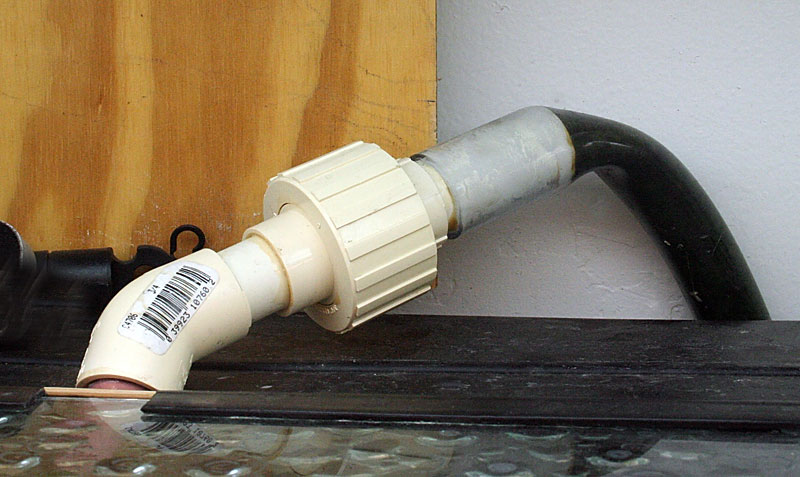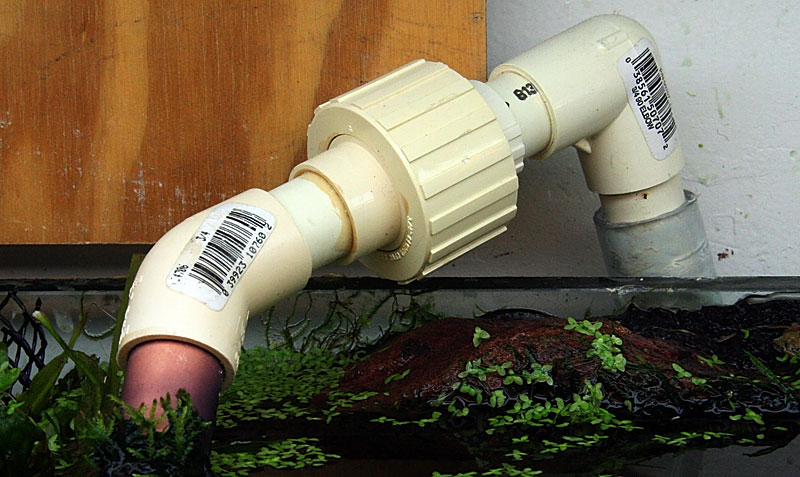The Return Pipes
 Return pipe coming over the back of the tank. Initially, I avoided 90 degree angles as much as possible to allow for an optimal water flow, but obviously a 90 degree angle would be far preferable over the kink that has developed here.
Return pipe coming over the back of the tank. Initially, I avoided 90 degree angles as much as possible to allow for an optimal water flow, but obviously a 90 degree angle would be far preferable over the kink that has developed here.
 Return pipe coming over the back of the tank. Improved setup using a 90 degree angle.
My Danner MagDrive 18 pumps have threaded ¾" connections at the outlet. You can go to Lowes or Home Depot and buy plumbing parts which fit right onto these. Since I used ¾" CPVC for my UGJ system, I used threaded ¾" CPVC connections here as well. However, since CPVC - unlike PVC - cannot be dyed (see UGJ section), next time I would aim to use PVC throughout. While I have been praising Home Depot over Lowes in the lighting section, I have to say that the Lowes in my area stock a much greater variety of plumbing parts than Home Depot. For example the important union connections are virtually impossible to get at Home Depot. When I need plumbing supplies, I usually head for Lowes. An important part in my return line is a check valve, which allows water to be pumped into the tank, but not to be siphoned back into the sump. Without this valve, at a power outage the entire content of my tank would siphon into the sump. Remember that the outlets of the return pipe are the UGJs, so not much water would remain in the tank and my fish would be on the dry. However even this disaster wouldn't flood my house, because the sump has an overflow into the house drain.
To prevent pump vibrations to be propagated throughout the plumbing system, and also to be a bit more flexible with the design of the return pipe and avoid lots of sharp turns, I used mostly clear ¾" PVC hose instead of pipe. The PVC hose slides easily over ¾" pipe when heated up, so no adapter is necessary. The easiest way to heat the hose up is by dipping it in boiling water. This makes it very soft and expandable, and with a little practice, you can slide it even over pipe that's a lot thicker. I have years of experience doing this in a chemistry lab. An added benefit is that the hose will return to its usual comparatively inflexible state when cooled to room temperature, which makes for a very snug hose-pipe connection, which often cannot be severed unless you cut the hose.
Return pipe coming over the back of the tank. Improved setup using a 90 degree angle.
My Danner MagDrive 18 pumps have threaded ¾" connections at the outlet. You can go to Lowes or Home Depot and buy plumbing parts which fit right onto these. Since I used ¾" CPVC for my UGJ system, I used threaded ¾" CPVC connections here as well. However, since CPVC - unlike PVC - cannot be dyed (see UGJ section), next time I would aim to use PVC throughout. While I have been praising Home Depot over Lowes in the lighting section, I have to say that the Lowes in my area stock a much greater variety of plumbing parts than Home Depot. For example the important union connections are virtually impossible to get at Home Depot. When I need plumbing supplies, I usually head for Lowes. An important part in my return line is a check valve, which allows water to be pumped into the tank, but not to be siphoned back into the sump. Without this valve, at a power outage the entire content of my tank would siphon into the sump. Remember that the outlets of the return pipe are the UGJs, so not much water would remain in the tank and my fish would be on the dry. However even this disaster wouldn't flood my house, because the sump has an overflow into the house drain.
To prevent pump vibrations to be propagated throughout the plumbing system, and also to be a bit more flexible with the design of the return pipe and avoid lots of sharp turns, I used mostly clear ¾" PVC hose instead of pipe. The PVC hose slides easily over ¾" pipe when heated up, so no adapter is necessary. The easiest way to heat the hose up is by dipping it in boiling water. This makes it very soft and expandable, and with a little practice, you can slide it even over pipe that's a lot thicker. I have years of experience doing this in a chemistry lab. An added benefit is that the hose will return to its usual comparatively inflexible state when cooled to room temperature, which makes for a very snug hose-pipe connection, which often cannot be severed unless you cut the hose.
Leave a Reply
You must be logged in to post a comment.
